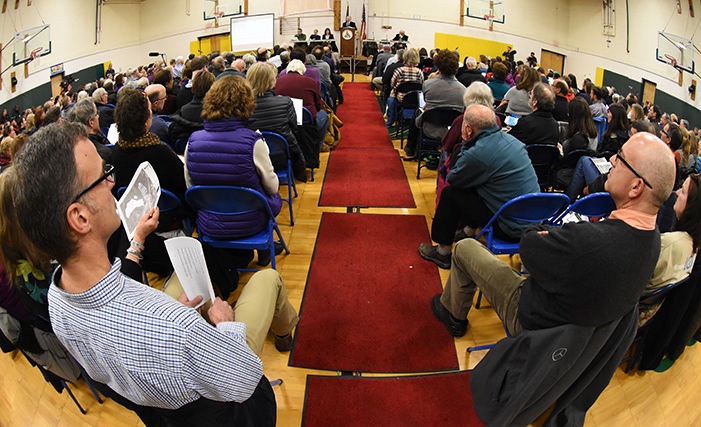“This board is willing to work with Vermont Railway to find an alternative site,” Shelburne Selectboard Chair Gary von Stange said, addressing the crowd as the board’s Feb. 9 meeting came to a close.
The statement was an echo of the desire that had been expressed by many throughout the course of the evening. Shelburne Community School was standing room only. About 500 attended.
The meeting was dedicated exclusively to the railway’s proposed intermodal facility that is to be located west of Harbour Industries. The meeting was the fourth board meeting on the subject since Vermont Rail System closed on the land Dec. 28.
Selectboard Member John Kerr offered up a summary of the project to start the meeting. “The town has taken exception to the railway’s claim of exemption,” Kerr said.
Kerr noted the railway has been making an effort to work with the town. He added that the town did not object to the development of the parcel but to the sorts of activities intended.
In a 20-minute presentation, representatives of Vermont Railway provided some more infor-mation on the project, including answers to some of the questions posed by Selectboard members.
Before introducing his team, Vermont Rail System President David Wulfson said, “I think we can move forward together.”
Jeff Nelson, VHB Director of Energy and Environmental Services, addressed environmental and safety concerns. He said that there will be a new deceleration turning lane added so that southbound trucks may safely enter the site from Route 7.
Nelson said the site had been evaluated for wetlands, streams, vernal pools, threatened and endangered species, floodplains and river corridors. The project, he said, is located outside of the 100-year floodplain and river corridor.
David Saladino, VHB Director of Transportation Engineering in Vermont, addressed traffic concerns. He said 85 percent of the new truck traffic will head northward. He added that most of the truck traffic should be early in the morning and mid-afternoon, missing peak traffic times.
Saladino said a traffic signal would not be warranted, but a right-turn lane is. He added that the area is not considered a designated crash area.
Seldon Houghton, Vermont Railway vice president, said that there are no plans for trains to block Harbor Road. He also said that the volume of salt is not doubling, just the amount of storage capacity. That added storage capacity, he said, will allow the railway to store salt in summer for winter.
Eric Benson, Vermont Railway general counsel, was the final speaker in the railway’s presentation. He addressed some of the questions that had been posed about Barrett Trucking. He said that the trucking company will not be relocating its headquarters to Shelburne. It serves as agent of the operator but that the railroad runs the whole show.
Benson showed a list of things he said the railroad was poised and ready to do, including donating additional conserved land to the town. He referenced the current litigation between the town and the railway, saying that every dollar spent fighting is one less the railroad would devote to helping the town, a comment that elicited upset from Selectboard Chair Gary von Stange.
Von Stange addressed Benson’s comments regarding litigation, saying, “This town will not succumb to a threat. We will do what we think is right for this town.”
Town Manager Joe Colangelo said he has some specific concerns regarding the site. He has talked with truck drivers who deliver to Harbor Industries, and they have described the entrance and exit a difficult one to navigate. He added that Police Chief Jim Warden has public safety concerns about the project.
Colangelo referenced a study that had been conducted a few years ago by the State of Vermont, which had concluded that the site was not conducive to truck traffic.
Josh Simonds, Lake Champlain Waldorf School school board member, stood up to speak after the presentation, as did about a dozen others. He described Waldorf ’s attempt at expansion, which had been turned down. He believes the railway should have to show how impactful its project will be, too.
Simonds added that the railway does not own the rails but, rather, leases them. There is a covenant, he said, that says they will abide by federal, state, and local laws, a covenant he does not believe the railway has abided by.
Marty Illick, Lewis Creek Association Executive Director, spoke of the regulations currently in place. She said that they fail to address climate change and that, while the project is meeting the regulations, it is not meeting the realities.
“Those river corridors are going to change,” Illick warned. She added that, “The salt shed is a good idea, but wrong location.”






















(0) comments
Welcome to the discussion.
Log In
Keep it clean. Please avoid obscene, vulgar, lewd, racist or sexual language.
PLEASE TURN OFF YOUR CAPS LOCK.
Don't threaten. Threats of harming another person will not be tolerated.
Be truthful. Don't knowingly lie about anyone or anything.
Be nice. No racism, sexism or any sort of -ism that is degrading to another person.
Be proactive. Use the "Report" link on each comment to let us know of abusive posts.
Share with us. We'd love to hear eyewitness accounts, the history behind an article.